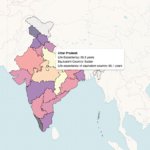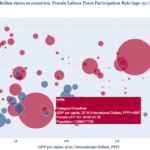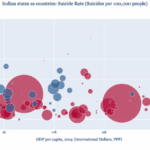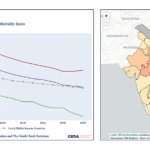Picture This: If Indian States Were Countries – Fertility Rate
India’s Total Fertility Rate (TFR) declined from 5.2 to 4.5 between 1971 and 1981, and from 3.6 to 2.2 between 1991 and 2018, according to SRS 2018. TFR of a population is the average number of children that would be born to a woman over her lifetime. According to the UN Population Division, a TFR of 2.1 children per woman is considered to be replacement level TFR. With a TFR of 2.1, a population would successfully replace itself without increasing or decreasing the numbers. As per SRS 2018, urban India had a TFR of 1.7 while rural India had a TFR of 2.4.
This shows that India’s overall TFR rate has declined to replacement levels and the focus on population control policies is misplaced.
If Indian states were countries, how would they compare with countries that may have a comparable GDP Per Capita in terms of TFR? In this fourth part in our series on Indian states as countries, we will turn our attention to TFR. In our previous instalments, we had looked at life expectancy, GDP per capita, and female labour force participation rateacross Indian states.
The graph above shows Indian states as blue bubbles and other countries as red bubbles. The size of the bubble is determined by the population of the state or the country. Their GDP Per Capita in Intl $ (International $, which according to the World Bank, “would buy in the cited country a comparable amount of goods and services a U.S. dollar would buy in the United States.”) is plotted against the x-axis, and their TFR (2018) is plotted against the y-axis.
Among Indian states, Delhi and West Bengal have the lowest TFR of 1.5. With GDP Per Capita of Intl $ 17,807, Delhi finds itself closest to Grenada (Intl $ 17,771) and ahead of China (Intl $ 16,773) but the state bests both in terms of TFR as China and Grenada have a higher TFR of 1.69 and 2.06 respectively. Similarly, West Bengal’s GDP Per Capita of Intl $ 5,345 places it between to Myanmar (Intl $ 5,297), and Nigeria (Intl $ 5,353) but its TFR of 1.5 is far lower than Myanmar (2.15) and Nigeria (5.39).
According to SRS 2018, Bihar’s TFR of 3.2 is the highest in the country with Uttar Pradesh following it at 2.9. But like Delhi, and West Bengal, Bihar with a GDP Per Capita of Intl $ 2,076, also finds itself doing better in terms of TFR than other countries which have a similar GDP Per Capita. Guinea-Bissau (Intl $ 2,021) has a TFR of 4.48, while Afghanistan (Intl $ 2,152) has a TFR of 4.47. Uttar Pradesh’s GDP Per Capita (Intl $ 3,310) places it between Vanuatu (Intl $ 3,250) and Benin (Intl $ 3,426) but its TFR of 2.9 is lower than both (Vanuatu: 3.78, Benin: 4.83).
The data for states’ TFR has been taken from SRS 2018 while their GDP Per Capita is calculated Ministry of Statistics and Program Implementation (MoSPI) report on Indian State Domestic Product 2019. For other countries both TFR and GDP Per Capita data have been taken from the World Bank database.
As per SRS 2018, eight states had a TFR higher than replacement level. These are Assam, Bihar, Chhattisgarh, Haryana, Jharkhand, Madhya Pradesh, Rajasthan, and Uttar Pradesh.
Data and visualization: Vibhav Khandelwal; Text: Ankur Bhardwaj
If you wish to republish this article or use an extract or chart, please read CEDA’s republishing guidelines.








